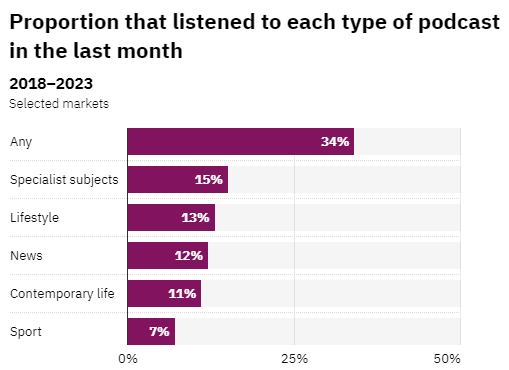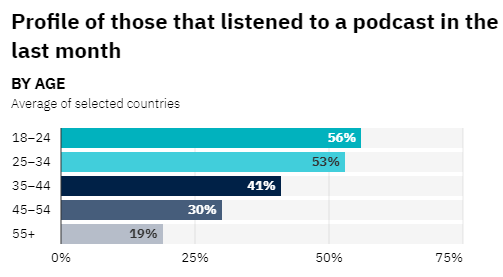An annual research study jointly conducted by Reuters Institute and Oxford University reveals the stability of news podcasts, and shapes the profile of the category listeners. (See the summary article HERE and PDF HERE.
A project of extraordinary reach, it is called News podcasts: who is listening and what formats are working. The international survey examines frequency of use, country-level comparisons, top ten rankers, and much more. This is a global research project, and the PDF delivers 160 pages of country-specific results.
The goal is “to understand how news podcasts fit into the wider ecosystem and to identify some of the most popular news podcasts across a number of countries.” One key takeaway is that the consumption of news podcasts has been stable in the life of this survey (2018-2023). Across 20 countries that these organizations have surveyed over five years, a steady 12% of respondents listen to news podcasts monthly:

As in U.S.-based surveys, the broad international sweep of the Reuters/Oxford study indicates that podcast listening is a youth market. The average ages of listening yield majorities in the 18-24 and 25-34 ranges:

From an advertisers perspective, other audience characteristics are favorable — which is to say indexing high in education and income.
We find the following note quite interesting:
“Overall consumption of news podcasts is highest in the United States (19%), but lower in many European countries such as France (9%) and the United Kingdom (8%). This difference reflects the vibrancy and range of news podcast production and monetisation in the United States, which in turn has driven public awareness and strong consumption. In many European countries, the existence of high-quality output from commercial and public service radio may have made it harder for an independent podcasting sector to gain traction.” –News podcasts: who is listening and what formats are working
There is a tremendous volume of cross-border information to be gleaned, and accessing the summary article and/or complete PDF is recommended. Nation-by-nation rankers, explanations for anomalies by country, and much more are available.
The work is sponsored by 19 organizations, including Google and NPR.

